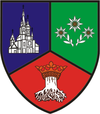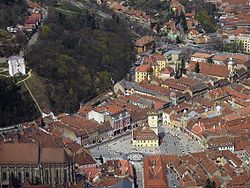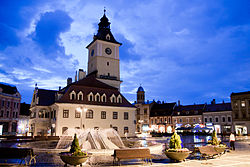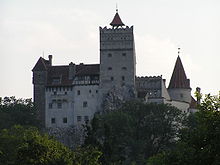- Brașov
-
Brașov — City — Brașov - medieval city 
Coat of armsLocation of Brașov
Coordinates: 45°40′N 25°37′E / 45.667°N 25.617°ECoordinates: 45°40′N 25°37′E / 45.667°N 25.617°E Country  Romania
RomaniaCounty Brașov County Status County capital Government – Mayor George Scripcaru (Democratic Liberal Party) Area – City 267.2 km2 (103.2 sq mi) – Metro 1,368.5 km2 (528.4 sq mi) Elevation 600 m (1,969 ft) Population (est. 2010[1][2]) – City 276,914 – Density 1,040/km2 (2,693.6/sq mi) – Metro  402,041
402,041Time zone EET (UTC+2) – Summer (DST) EEST (UTC+3) Website http://www.brasovcity.ro Brașov (Romanian pronunciation: [braˈʃov] (
 listen); German: Kronstadt; Hungarian: Brassó, Hungarian pronunciation: [’brɒʃʃoː]; Medieval Latin: Brassovia or Corona; 1950–1960: Orașul Stalin) is a city in Romania and the capital of Brașov County.
listen); German: Kronstadt; Hungarian: Brassó, Hungarian pronunciation: [’brɒʃʃoː]; Medieval Latin: Brassovia or Corona; 1950–1960: Orașul Stalin) is a city in Romania and the capital of Brașov County.According to the last Romanian census, from 2002, there were 284,596 people living within the city of Brașov, making it the 8th most populated city in Romania.
Brașov is located in the central part of the country, about 166 km north of Bucharest. It is surrounded by the Southern Carpathians and is part of the Transylvania region.
The city is notable for being the birthplace of the national anthem of Romania and for hosting the Golden Stag International Music Festival.
Contents
Etymology
The city was first attested in 1235 AD under the name Corona, a Latin word meaning "crown", a name given by the German colonists. The current Romanian and Hungarian names are derived from the Turkic word barasu, meaning "white water" with a Slavic suffix -ov.[3]
The first attested mention of Brașov is Terra Saxonum de Barasu ("Saxon Land of Baras") in a 1252 document. The German name Kronstadt means "Crown City" and is reflected in the city's coat of arms as well as in its Medieval Latin name, Corona. The two names of the city ', Kronstadt and Corona, were used simultaneously in the Middle Ages.
From 1950 to 1960, during part of the Communist period in Romania, the city was called Orașul Stalin (Stalin City), after the Soviet leader Joseph Stalin.[4]
History
The Black Church
The oldest traces of human activity and settlements in Brașov date back to the Neolithic age (about 9500 BCE). Archaeologists working from the last half of the 19th century discovered continuous traces of human settlements in areas situated in Brașov: Valea Cetăţii, Pietrele lui Solomon, Șprenghi, Tâmpa, Dealul Melcilor, and Noua. The first three locations shows traces of Dacian citadels; Șprenghi Hill housed a Roman-style construction. The last two locations had their names applied to Bronze Age cultures—Schneckenberg ‘Hill of the Snails’ (Early Bronze Age[5]) and Noua 'The New’ (Late Bronze Age[6]).
German colonists known as the Transylvanian Saxons played a decisive role in Brașov's development. These Germans were invited by King Géza II of Hungary to develop towns, build mines, and cultivate the land of Transylvania at different stages between 1141 and 1162. The settlers came primarily from the Rhineland, Flanders, and the Moselle region, with others from Thuringia, Bavaria, Wallonia, and even France.
In 1211, by order of King Andrew II of Hungary, the Teutonic Knights fortified the Burzenland to defend the border of the Kingdom of Hungary. On the site of the village of Brașov, the Teutonic Knights built Kronstadt – the city of the crown.[7] Although the crusaders were evicted by 1225, the colonists they brought in remained, along with local population, as did three distinct settlements they founded on the site of Brașov:
- Corona, around the Black Church (Biserica Neagră);
- Martinsberg, west of Cetăţuia Hill;
- Bartholomä, on the eastern side of Sprenghi Hill.
Germans living in Brașov were mainly involved in trade and crafts. The location of the city at the intersection of trade routes linking the Ottoman Empire and Western Europe, together with certain tax exemptions, allowed Saxon merchants to obtain considerable wealth and exert a strong political influence. They contributed a great deal to the architectural flavor of the city. Fortifications around the city were erected and continually expanded, with several towers maintained by different craftsmen's guilds, according to medieval custom. Part of the fortification ensemble was recently restored using UNESCO funds, and other projects are ongoing. At least two entrances to the city, Poarta Ecaterinei (or Katharinentor) and Poarta Șchei (or Waisenhausgässertor), are still in existence. The city center is marked by the mayor's former office building (Casa Sfatului) and the surrounding square (piaţa), which includes one of the oldest buildings in Brașov, the Hirscher Haus. Nearby is the "Black Church" (Biserica Neagră), which some claim to be the largest Gothic style church in Southeastern Europe.
Once Brașov became a German colony, Romanians were denied several privileges by the new German settlers. They were no longer recognized as citizens of the city, and as such they were no longer able to continue to practice their crafts and operate their businesses. Additionally, their primary religion (Orthodox) was not officially recognized throughout Transylvania, especially during and after the 15th century.
The cultural and religious importance of the Romanian church and school in Șchei is underlined by the generous donations received from more than thirty hospodars of Moldavia and Wallachia, as well as that from Elizabeth of Russia. In the 17th and 19th centuries, the Romanians in Șchei campaigned for national, political, and cultural rights, and were supported in their efforts by Romanians from all other provinces, as well as by the local Greek merchant community. In 1838 they established the first Romanian language newspaper Gazeta Transilvaniei and the first Romanian institutions of higher education (Școlile Centrale Greco-Ortodoxe - "The Greek-Orthodox Central Schools", today named after Andrei Șaguna). The Holy Roman Emperor and sovereign of Transylvania Joseph II awarded Romanians citizenship rights for a brief period during the latter decades of the 18th century.
In 1850 the town had 21,782 inhabitants: 8,874 (40.7%) Germans, 8,727 (40%) Romanians, 2,939 (13.4%) Hungarians.[8] In 1910 the town had 41,056 inhabitants: 10,841 (26.4%) Germans, 11,786 (28.7%) Romanians, 17,831 (43.4%) Hungarians. [8] In World War I, the town was occupied by Romanian troops between 16 August and 4 October in 1916 during Battle of Transylvania.
In 1918, when Transylvania joined Romania by the "Proclamation of Union" of Alba Iulia (adopted by the Deputies of the Romanians from Transylvania) Deputies of the Saxons from Transylavania supported it, with their vote to be part of Romania, and declared their allegiance to the new Romanian state. The inter-war period was a time of flourishing economic and cultural life in general, which included the Saxons in Brașov as well. However, at the end of World War II many ethnic Germans were forcibly deported to the Soviet Union, and many more emigrated to West Germany after Romania became a communist country.
Jews have lived in Brașov since 1807, when Aron Ben Jehuda was given permission to live in the city, a privilege until then granted only to Saxons. The Jewish community of Brașov was officially founded 19 years later, followed by the first Jewish school in 1864, and the building of the synagogue in 1901. The Jewish population of Brașov was 67 in 1850, but it expanded rapidly to 1,280 people in 1910 and 4,000 by 1940. Today the community has about 230 members, after many families left for Israel between World War II and 1989.
Like many other cities in Transylvania, Brașov is also home for a significant ethnic Hungarian minority.
During the communist period, industrial development was vastly accelerated. Under Nicolae Ceaușescu's rule, the city was the site of the 1987 Brașov strike. This was repressed by the authorities and resulted in numerous workers being imprisoned.
Economy
Industrial development in Brașov started in the inter-war period, with one of the largest factories being the airplane manufacturing plant (IAR Brașov), which produced the first Romanian fighter planes, which were used in World War II against the Soviets. After Communist rule was imposed, the plant was converted to manufacture of agricultural equipment, being renamed "Uzina Tractorul Brașov" (internationally known as Universal Tractor Brașov).
Industrialization was accelerated in the Communist era, with special emphasis being placed on heavy industry, attracting many workers from other parts of the country. Heavy industry is still abundant, including Roman, which manufactures MAN AG trucks as well as native-designed trucks and coaches. Although the industrial base has been in decline in recent years, Brașov is still a site for manufacturing agricultural tractors and machinery, hydraulic transmissions, auto parts, ball-bearings, helicopters (at the nearby IAR site in Ghimbav), building materials, tools, furniture, textiles, shoes and cosmetics. There are also chocolate factories and a large brewery. In particular, the pharmaceutical industry has undergone further development lately, with GlaxoSmithKline establishing a production site in Brașov.
A large longwave broadcasting facility is located near Brașov, at Bod.
Significant growth in real estate prices continues, along with other major Romanian cities, as investor sentiment remains high, given the large foreign direct investment influx, recent accession to the European Union and forthcoming airport. Like most of Romania and Poland, cities like Brașov are predicted to exhibit strong growth for many years to come. Many foreign investors are sourcing their own land, or engaging local firms to create holiday or investment property.
Demographics
Historical population of Brașov Year Population %± 1890 30,781 — 1900 34,511[9] 12.1% 1910 census 41,056 18.9% 1930 census 59,232 44.2% 1948 census 82,984 40% 1965 estimate 140,500[10] 69.3% 1975 estimate 206,156[11] 46.7% 1983 estimate 331,240[12] 60.6% 1992 census 323,736 −2.2% 2002 census 284,596 −12% 2007 estimate 277,945[13] −2.3% The municipality of Brașov has a total population of 284,596 (2002 Census). Its ethnic composition includes:
- Romanians: 222,580 (90.66%)
- Hungarians: 23,204 (8.54%)
- Ethnic Germans: 1,717 (0.60%)
- Romani people: 762 (0.26%)
- Other ethnicities (Russians, Greeks, Italians): 871 (0.31%)
According to the latest official estimates, from 2010, 276,914 inhabitants live within the city limits.[2]
In 2005, the Brașov metropolitan area was created. With its surrounding localities, Brașov has around 400,000 inhabitants.[14]
Education
Primary Schools
- 30 Primary Schools
High Schools
- Colegiul National “Dr. Ioan Mesota”
- Colegiul National de Informatica “Gr. Moisil”
- Colegiul National “Andrei Saguna”
- Colegiul National “Unirea”
- Liceul “Andrei Muresanu”
- Liceul Teoretic “J. Honterus”
- Colegiul de Stiinte ale Naturii “E. Racovita”
- Liceul “Nicolae Titulescu”
- Liceul de Arta
- Liceul cu Program Sportiv
- Colegiul de stiinte “Grigore Antipa”
- Liceul Teoretic “C. Brancoveanu”
- Seminarul Teologic Liceal Ortodox “D. Staniloaie”
- Colegiul Tehnic “Astra”
- Colegiul Tehnic “Mircea Cristea”
- Colegiul Tehnic “Iosif Silimon”
- Colegiul Tehnic “Sfintii Voievozi”
- Grupul Scolar de Arte si Meserii
- Colegiul Tehnic “Remus Radulet”
- Colegiul Tehnic Feroviar
- Grupul Scolar Industrial Auto
- Colegiul Tehnic “Maria Baiulescu”
- Grupul Scolar Ind. de Constr. Montaj
- Colegiul National Ec. “Andrei Barseanu”
- Grupul Scolar Silvic “Dr. N. Rucareanu”
- Grupul Scolar de Turism si Alim. Publica
- Liceul “FEG”
- Liceul “Europa Unita”
- Colegiul National “Aprily Lajos”
Universities:
- Transylvania University of Brașov
- George Bariţiu University
- Spiru Haret University
- Christian University Dimitrie Cantemir
- Academia Fortelor Aeriene Henri Coanda
- Fundatia Univ. Sf. Apostoli Petru si Pavel
- Universitatea Sextil Puscariu
- Universitatea Romano Canadiana
Transportation
The Brașov local transport network is well-developed, with around 50 bus and trolleybus lines. There is also a regular bus line serving Poiana Brașov, a nearby winter resort. Because of its central location, the Brașov railway station is one of the busiest stations in Romania with trains to/from most destinations in the country served by rail.
The construction of Braşov Airport[15] was initiated by Intelcan Canada on April 15, 2008. Construction is planned to be finalized in 24 to 30 months. The project consists of a terminal capable of handling 1 million passengers per year and a 2,800 meter-long runway. The A3 highway is also planned to pass the city.
Tourism
 Poiana Brașov, a possible bid for the Olympic Winter Games[citation needed]
Poiana Brașov, a possible bid for the Olympic Winter Games[citation needed]
Centrally located Brașov is a good starting point for trips around Romania. The city is situated at fairly equal distances from several tourism destinations in the country: the Black Sea resorts, the monasteries in northern Moldavia, and the well-preserved wooden churches of Maramureş. It is also the largest city in a mountain resorts area. The old city is very well preserved and is best seen by taking the cable-car to the top of Tâmpa Mountain.
Temperatures from May to September fluctuate around 23 °C (73 °F). Brașov benefits from a winter tourism season centered on winter sports and other activities. Poiana Brașov is the most popular Romanian ski resort and an important tourist center preferred by many tourists from other European states.
Sights
Bran Castle, situated in the immediate vicinity of Brașov
- Biserica Neagră ("The Black Church"), a celebrated Gothic site - the building dates from 1477, when it replaced an older church (demolished around 1385). Its acquired the name after being blackened by smoke from the 1689 great fire.
- Casa Sfatului ("The mayor's former office building"). The administration for Brașov was here for more than 500 years.
- Biserica Sf. Nicolae (St. Nicholas Church), dating back to the 14th century.
- The First Romanian School, a museum with the first Romanian printing press among many other firsts.
- The Rope Street, the narrowest street in Romania.
- Şchei, the historically Bulgarian but then Romanian neighborhood outside of the old walled city.
- Catherine's Gate, the only original city gate to have survived from medieval times.
- Şchei Gate, next to Catherine's Gate, built in 1827.
- The Orthodox church of the Dormition of the Theotokos, built in 1896.
- Muzeul Prima Carte Românească, a museum exhibiting the first book printed in the Romanian language.
- Tâmpa, a small mountain in the middle of the city (900m above sea level), a sightseeing spot near the old city center.
- The "Brașov Citadel Fortress" - Cetăţuia Brașovului
- The nearby Bran Castle, attracting many fans of Dracula and often (but incorrectly) said to have been the home of Vlad the Impaler.
- Poiana Brașov, mainly a ski resort but also a sightseeing spot.
- Râşnov Fortress, above the nearby town of Râşnov, is a restored peasant fortress
- Prejmer Fortress, in the nearby town of Prejmer
Twin cities
 Tampere, Finland[16]
Tampere, Finland[16] Tours, France
Tours, France Győr, Hungary
Győr, Hungary Rishon LeZion, Israel
Rishon LeZion, Israel Holstebro, Denmark
Holstebro, Denmark Musashino, Japan
Musashino, Japan Ghent, Belgium
Ghent, Belgium Leeds, United Kingdom
Leeds, United Kingdom Minsk, Belarus
Minsk, Belarus Trikala, Greece
Trikala, Greece Venaria Reale, Italy
Venaria Reale, Italy
Sport
The city has a long tradition in sports, the first sport associations being established at the end of the 19th century (Target shooting Association, Gymnastics School). The Transylvanian Sports Museum is among the oldest in the country and presents the evolution of consecrated sports in the city. During the communist period, universiades and daciades (derived from "dacian") were held, where local sportmen were obliged to participate. Nowadays, the infrastructure of the city allows other sports to be practiced, such as football, rugby, tennis, cycling, handball, gliding, skiing, skating, mountain climbing, paintball, bowling, swimming, target shooting, basketball, martial arts, equestrian, volleyball or gymnastics. Annually, at "Olimpia" sports ground, the "Brașov Challenge Cup" tennis competition is held.
The only football champion team based in the city was Colţea Brașov, winning the championship in 1928 and managing second place in 1927, in only 10 years of existence (1921–1931). Is was succeeded by Brașovia Brașov. Brașov hosted the Group A fixtures of the 2008 IIHF World Championship Division II ice hockey tournament. There were 15 games held between April 3 and April 13.
Brașov is set to host the 2013 European Youth Winter Olympic Festival.
Local teams
- FC Brașov soccer club
- ASC Corona Brașov
- Rulmentul Brașov handball club
- CSU Brașov basketball team
- SCM Fenestela Brașov ice hockey club
- CFR Brașov rugby football club
- Bridge Club Brașov contract bridge club
Sports venues
Name Capacity Built Usage Municipal Stadium 30,000 (on benches) ~1975 1 May and 23 August parades; rarely used for football matches;
closed and demolished in 2008Brașov Arena 23,000 seats planned 2010 football stadium;
construction started in 2008 with the demolishing of the old stadium;Tineretului / "Silviu Ploiesteanu" Stadium 12,670 seats 1960 football stadium; currently, the capacity is ~10,000 people, as one of the main stands is being remodeled;
floodlights only installed in 2009;"D.P. Colibasi" Sports Hall 2,300 seats ~1970 indoor sports: handball, basketball, volleyball, sometimes others Brașov Olympic Skating Rink 2,000
(1,600 seats + 400 standing)2010 mainly ice hockey;
inaugurated February 18, 2010Gallery
-
The infamous Hollywood-like sign on top of Mt. Tâmpa
-
IAR Factory 1940
See also
Notes
- ^ "Largest cities in Romania" (in Romanian). Agerpres. February 2, 2010. http://www.agerpres.ro/english/index.php/component/k2/item/173.html. Retrieved June 13, 2010.
- ^ a b "Largest Romanian cities on July 1, 2010" (in Romanian). evz.ro. August 28, 2011. http://www.evz.ro/detalii/stiri/iasi-sau-timisoara-care-este-cel-de-al-doilea-mare-oras-din-romania-dupa-bucuresti-943339.html. Retrieved August 28, 2011.
- ^ Alexandru Madgearu, "Români şi pecenegi în sudul Transilvaniei", Editura Economică, 2005, ISBN 973-709-158-2
- ^ Brasov | Travel To Romania
- ^ Coles & Harding 1979, p. 140.
- ^ Coles & Harding 1979, p. 410.
- ^ Mediaeval studies, Volumes 17-18, Pontifical Institute of Mediaeval Studies, 1955, Toronto, Canada, An annual journal of scholarship, History, ISSN 0076–5872
- ^ a b Erdély etnikai és felekezeti statisztikája
- ^ Encyclopædia Britannica Eleventh Edition
- ^ Dictionar Enciclopedic Roman vol.IV, Editura Politica Bucuresti, 1966 (Romanian)
- ^ Statele Lumii, Editura Stiintifica si Enciclopedica Bucuresti, 1976 (Romanian)
- ^ Statele Lumii, Editura Stiintifica si Enciclopedica Bucuresti, 1985 (Romanian)
- ^ Romania in Cifre-2008 (Romanian)
- ^ "Populaţia stabilă la 1.01.2009" (in Romanian). INSSE. May 19, 2009. http://www.insse.ro/cms/rw/resource/populatia%20stabila%20la%201%20ianuarie%202009%20si%2018.xls?download=true. Retrieved May 20, 2009.
- ^ Website of the Braşov Airport
- ^ [1]
References
- Coles, John; Harding, A.F. (1979). The Bronze Age in Europe pages 140’'. Routledge. ISBN 978-0416706505.
- "O istorie a Braşovului" ("A history of Brasov") - Ion Dumitraşcu, Mariana Maximescu, Phoenix, Braşov, 2001
- "Fortificaţia dacică de la Braşov - Pietrele lui Solomon" ("The Dacian citadel from Braşov - Pietrele lui Solomon"), Fl. Costea, CumidavaXX, Braşov, 1996
- "Săpăturile de salvare de pe dealul Şprenghi" ("The diggings for saving [the archaeological evidences] from Şprenghi Hill" - the hill was a quarry) A. Alexandrescu, N. Constantinescu, Bucureşti, 1959
- "Die spätneolitischen Ansiedlungen mit bemalter Keramik aus oberem Laufe des Altflusses", J. Teutsch, Mitteilungen der Prehistorischen Komision, I, Wien.
External links
- City Hall Official Website;
- (Romanian) Map of Brașov with route planning, points of interest, public transport, openmap.ro
- German Cultural Center, kulturzentrum-kronstadt.ro
- Art Museum Braşov, muzeulartabv.ro
Brașov County, Romania Cities 
Towns Communes Apața · Augustin · Beclean · Bod · Bran · Budila · Bunești · Cața · Cincu · Comăna · Cristian · Crizbav · Drăguş · Dumbrăviţa · Feldioara · Fundata · Hălchiu · Hărman · Hârseni · Hoghiz · Holbav · Homorod · Jibert · Lisa · Mândra · Măieruş · Moieciu · Ormeniş · Părău · Poiana Mărului · Prejmer · Racoş · Recea · Şercaia · Şinca · Şinca Nouă · Sâmbăta de Sus · Sânpetru · Şoarş · Tărlungeni · Teliu · Ticuşu · Ucea · Ungra · Vama Buzăului · Viştea · Voila · Vulcan
250,000+ 100,000+ Ploiești · Brăila · Oradea · Bacău · Arad · Pitești · Sibiu · Târgu Mureș · Baia Mare · Buzău · Satu Mare · Botoșani · Râmnicu Vâlcea · Suceava · Piatra Neamț · Drobeta-Turnu Severin · Focșani
County seats of Romania (alphabetical order by county) Alba Iulia • Arad • Piteşti • Bacău • Oradea • Bistriţa • Botoşani • Braşov • Brăila • Buzău • Reşiţa • Călăraşi • Cluj-Napoca • Constanţa • Sfântu Gheorghe • Târgovişte • Craiova • Galaţi • Giurgiu • Târgu Jiu • Miercurea-Ciuc • Deva • Slobozia • Iaşi • Buftea • Baia Mare • Drobeta-Turnu Severin • Târgu Mureş • Piatra Neamţ • Slatina • Ploieşti • Satu Mare • Zalău • Sibiu • Suceava • Alexandria • Timișoara • Tulcea • Vaslui • Râmnicu Vâlcea • Focşani
Bucharest (national capital) Categories:
Categories:- Braşov
- Populated places in Braşov County
- Cities in Romania
- Castles of the Teutonic Knights
Wikimedia Foundation. 2010.
































